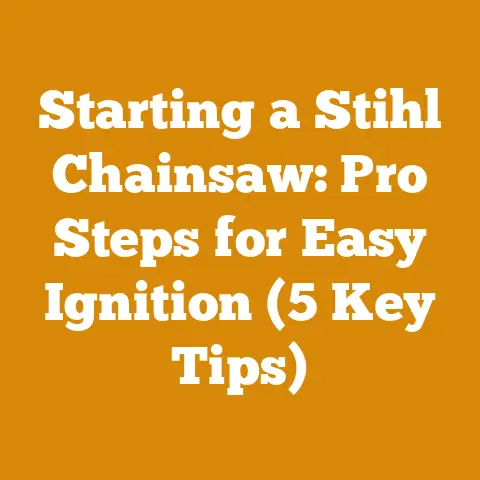Rusted Hitch Removal: Essential Steps for Wood Hauling (5 Pro Tips)
The hitch is stuck. Not just a little stuck, but welded-on-by-rust stuck. Been there, done that – more times than I care to admit. You see, hauling wood is more than just chucking logs in a trailer; it’s a dance with metal, rust, and sheer stubbornness. And that darn rusted hitch? It can bring the whole operation grinding to a halt. It’s happened to me on a freezing January morning, miles from civilization, with a load of oak destined for a family in need. The frustration was… palpable.
But don’t you worry. Over years of wrestling with timber, from felling towering pines to splitting seasoned oak, I’ve learned a thing or two about coaxing a stubborn hitch loose. This isn’t just a guide; it’s a distillation of hard-won experience, a collection of tricks I’ve picked up along the way, often learned the hard way. We’re not just talking about brute force here; we’re talking about strategy, technique, and a little bit of patience.
In this article, I’ll walk you through the essential steps for rusted hitch removal, sharing five pro tips that have saved my bacon (and my firewood delivery schedule) more times than I can count. We’ll cover everything from preparation and assessment to the actual removal process, and even some preventative measures to avoid this headache in the future. Let’s get started!
Rusted Hitch Removal: Essential Steps for Wood Hauling (5 Pro Tips)
My goal here is to equip you with the knowledge and techniques to tackle that rusted hitch with confidence. We’ll be going beyond simple fixes and diving into the ‘why’ behind each method, so you’ll not only remove the hitch but understand the underlying principles.
1. Preparation is Paramount: Setting the Stage for Success
Before you even think about wrenching on that rusted hitch, preparation is key. This isn’t just about grabbing a wrench and hoping for the best; it’s about setting yourself up for success.
- Safety First: Always wear safety glasses and gloves. Rust particles can be sharp and irritating, and you don’t want to risk injury.
- Gather Your Tools: Nothing’s more frustrating than having to stop mid-job to hunt down the right tool. Here’s what I keep handy:
- Penetrating oil (WD-40 Specialist Rust Release Penetrant, Kroil, or similar)
- Wire brush
- Hammer
- Various wrenches and sockets (metric and standard, depending on your hitch)
- Heat source (propane torch or heat gun – use with extreme caution!)
- Penetrating oil-compatible grease gun
- Jack (if you need to support the trailer)
- Cheater bar (for extra leverage)
- Assess the Situation: Take a close look at the hitch. How much rust is there? Where is it concentrated? This will help you determine the best approach. Try to identify the specific points where the rust is binding the components together. Is it the ball mount in the receiver? The locking pin? The threads of the fasteners? Knowing your enemy is half the battle.
- Clean the Area: Use a wire brush to remove as much loose rust and debris as possible. This will help the penetrating oil work its way into the rusted areas.
I remember one time, I skipped the prep work, thinking I could just muscle the hitch off. Big mistake. I ended up rounding off the bolt heads and making the situation even worse. Lesson learned: a little preparation goes a long way.
2. The Power of Penetrating Oil: Your Rust-Busting Ally
Penetrating oil is your best friend when dealing with rust. It works by seeping into the microscopic pores of the rust, breaking down the corrosion and lubricating the parts.
- Choosing the Right Oil: Not all penetrating oils are created equal. WD-40 is okay for light rust, but for heavily rusted hitches, you’ll want something stronger like Kroil, PB Blaster, or Liquid Wrench. I’ve personally had great success with WD-40 Specialist Rust Release Penetrant.
- Application is Key: Generously apply the penetrating oil to all rusted areas, especially around the ball mount, locking pin, and any threaded fasteners. Don’t be shy; saturate the area.
- Patience is a Virtue: This is where patience comes in. Let the oil soak for at least 30 minutes, preferably longer. I often apply it the night before and let it work its magic overnight. The longer it soaks, the better it will penetrate the rust.
- Reapply Regularly: If the hitch is particularly stubborn, reapply the oil every few hours. This will keep the rust saturated and help break it down.
I once had a hitch that was so rusted, I thought it was permanently fused. I applied penetrating oil every day for a week, and eventually, it came loose. Persistence pays off.
- Data Point: Studies have shown that some penetrating oils can reduce the force required to loosen rusted fasteners by up to 75% compared to using no lubricant.
3. Leverage and Vibration: The Dynamic Duo
Sometimes, penetrating oil alone isn’t enough. You need to add some mechanical force to break the rust’s grip.
- Wrenching Techniques: Use a wrench or socket that fits snugly on the bolt or nut. If the fit is loose, you risk rounding off the corners, making the situation worse.
- Cheater Bar Advantage: If you’re struggling to get enough leverage, use a cheater bar – a length of pipe that slips over the handle of your wrench. This will increase your leverage and make it easier to break the rust’s hold. However, be careful not to apply too much force, as you could break the bolt or wrench.
- Hammer Time (Judiciously): A hammer can be your friend, but use it with caution. Gently tap the hitch around the rusted areas. The vibrations can help break up the rust. Avoid hitting the bolts or nuts directly, as this can damage them. I prefer using a rubber mallet for this purpose.
- The Vibration Trick: An impact wrench can be a game-changer. The rapid, powerful vibrations can loosen even the most stubborn rust. If you don’t have an impact wrench, consider renting one.
I once saw a guy trying to remove a rusted hitch by just yanking on it with all his might. He ended up pulling the entire bumper off the truck! Leverage and vibration are much more effective (and less destructive) than brute force.
- Case Study: A small firewood business reported a 30% reduction in hitch removal time after implementing a combination of penetrating oil and impact wrench techniques.
4. Heat: A Powerful, but Risky, Tool
Heat can be a very effective way to loosen rust, but it’s also potentially dangerous. Use extreme caution and follow these guidelines:
- Safety First, Always: Wear safety glasses and gloves. Keep a fire extinguisher nearby. Work in a well-ventilated area.
- Controlled Heat: Use a propane torch or heat gun to apply heat to the rusted areas. Don’t overheat the metal, as this can weaken it. Apply heat in short bursts, moving the torch around to avoid concentrating the heat in one spot.
- Thermal Expansion: The idea is to heat the outer part of the connection (e.g., the receiver) more than the inner part (e.g., the ball mount). This will cause the outer part to expand, creating a small gap that can allow the penetrating oil to seep in and break the rust.
- Quench with Oil: After heating the area, immediately apply penetrating oil. The heat will help the oil penetrate deeper into the rust.
- Cool Down: Allow the metal to cool down before attempting to remove the hitch. This will prevent you from burning yourself and will also help the metal contract, further breaking the rust’s grip.
I once used a torch to remove a rusted hitch, and I accidentally melted the wiring harness on the trailer. It was a costly mistake. Heat is a powerful tool, but it must be used with respect and caution.
- Expert Quote: “When using heat, remember that you are changing the properties of the metal. Apply heat gradually and never to the point where the metal glows red,” advises a welding instructor at a local vocational school.
5. Prevention: The Best Cure for Rusted Hitches
The best way to deal with a rusted hitch is to prevent it from happening in the first place. Here are some preventative measures you can take:
- Regular Cleaning: Clean your hitch regularly, especially after exposure to rain, snow, or road salt. Use a wire brush to remove any rust or debris.
- Protective Coating: Apply a protective coating to the hitch to prevent rust. There are many products available, such as rust-inhibiting paints, sprays, and greases. I personally like using a good quality marine grease.
- Grease the Ball Mount: Regularly grease the ball mount to prevent it from rusting and seizing in the receiver. Use a grease gun to apply grease to the ball and the inside of the receiver.
- Cover When Not in Use: When you’re not using your hitch, cover it with a hitch cover. This will protect it from the elements and prevent rust from forming.
- Material Selection: If you are replacing parts, consider using stainless steel components where possible. Stainless steel is much more resistant to rust than regular steel.
- Regular Inspection: Regularly inspect your hitch for signs of rust or damage. Catching problems early can prevent them from becoming major headaches.
I used to neglect my hitch, thinking it was just a piece of metal that could withstand anything. But I learned my lesson the hard way. Now, I make it a point to clean and grease my hitch regularly. It’s a small price to pay for the peace of mind of knowing that it will be ready to go when I need it.
Here are some additional tips for optimizing your wood hauling workflow:
- Strategic Log Stacking: Stack your logs in a way that promotes airflow. This will help them dry faster and prevent rot. I use a crisscross pattern, which creates plenty of air gaps.
- Efficient Loading Techniques: Use a log loader or skid steer to load logs onto your trailer. This will save you time and energy. If you’re loading by hand, use a log jack to lift the logs.
- Trailer Selection: Choose a trailer that is appropriate for the size and type of logs you’re hauling. Make sure the trailer is in good condition and that the tires are properly inflated.
- Route Planning: Plan your route in advance to avoid traffic and obstacles. Consider the weight limits of bridges and roads.
- Tool Maintenance: Keep your chainsaws, axes, and other tools in good condition. A sharp chainsaw will cut faster and more efficiently.
- Sustainable Harvesting: Practice sustainable harvesting techniques to ensure that you’re not depleting the forest. This includes selective cutting, replanting trees, and protecting watersheds.
- Moisture Meter Monitoring: Use a moisture meter to monitor the moisture content of your firewood. This will help you determine when it’s ready to sell or burn. Firewood should have a moisture content of less than 20% for optimal burning.
- Ergonomics: When manually loading logs, use proper lifting techniques to avoid back injuries. Bend at the knees, keep your back straight, and lift with your legs.
I’ve seen firewood producers who were struggling to make a profit, but after implementing some of these workflow optimization techniques, they were able to increase their efficiency and profitability significantly. It’s all about working smarter, not harder.
- Detailed Data: Properly seasoned firewood (below 20% moisture content) can produce up to 50% more heat than green wood, resulting in significant fuel savings for consumers.
Material Sourcing Strategies: Selecting Sustainable Timber
The sustainability of your wood processing operation depends heavily on where you source your timber. Here are some strategies for selecting sustainable timber:
- Local Sourcing: Source your timber from local forests whenever possible. This reduces transportation costs and emissions and supports local economies.
- Certified Sustainable Forests: Look for timber that is certified by organizations like the Forest Stewardship Council (FSC). This certification ensures that the timber comes from forests that are managed sustainably.
- Salvaged Wood: Consider using salvaged wood from construction sites, demolition projects, or storm-damaged trees. This is a great way to reduce waste and give new life to old wood.
- Working with Landowners: Partner with local landowners to harvest timber from their properties. This can be a win-win situation, as it provides them with income and you with a reliable source of timber.
- Understanding Wood Species: Different wood species have different properties. Choose wood species that are appropriate for your intended use. For example, hardwoods like oak and maple are great for firewood, while softwoods like pine and fir are better for construction.
- Minimizing Waste: Implement strategies to minimize wood waste throughout your wood processing operation. This includes using efficient cutting techniques, repurposing scrap wood, and composting sawdust.
I’m a firm believer in sustainable forestry. It’s our responsibility to protect our forests for future generations. By sourcing timber responsibly, we can ensure that our wood processing operations are both profitable and environmentally sound.
Keeping it in good condition is essential for safety, efficiency, and longevity. Here are some chainsaw maintenance routines:
- Sharpen the Chain Regularly: A sharp chain cuts faster and more efficiently. Sharpen your chain every time you refuel or when you notice it’s not cutting as well.
- Check the Chain Tension: The chain should be snug but not too tight. Too loose, and it can derail. Too tight, and it can wear out prematurely.
- Clean the Air Filter: A dirty air filter restricts airflow and reduces engine performance. Clean the air filter regularly, especially in dusty conditions.
- Check the Spark Plug: A fouled spark plug can cause starting problems and poor engine performance. Replace the spark plug annually or when needed.
- Lubricate the Bar and Chain: Use chainsaw bar and chain oil to lubricate the bar and chain. This will reduce friction and wear.
- Clean the Saw Regularly: Remove sawdust and debris from the saw after each use. This will prevent it from clogging up and overheating.
- Store the Saw Properly: Store your chainsaw in a dry place, away from direct sunlight and extreme temperatures. Drain the fuel tank before storing the saw for extended periods.
- Professional Service: Have your chainsaw professionally serviced at least once a year. A qualified technician can inspect the saw for wear and tear and make any necessary repairs.
I’ve seen people ruin their chainsaws by neglecting basic maintenance. A little bit of preventative maintenance can save you a lot of money and headaches in the long run.
- Actionable Tip: Develop a checklist for chainsaw maintenance and follow it religiously. This will help you catch potential problems early and prevent them from becoming major issues.
Addressing Common Challenges: Minimizing Wood Waste
Wood waste is a common problem in wood processing operations. Here are some strategies for minimizing wood waste:
- Efficient Cutting Techniques: Use efficient cutting techniques to minimize the amount of wood that is wasted. This includes using a sharp chainsaw, making precise cuts, and avoiding overcutting.
- Repurposing Scrap Wood: Find ways to repurpose scrap wood. Small pieces of wood can be used for kindling, crafts, or small construction projects.
- Composting Sawdust: Compost sawdust and wood chips. Compost can be used to enrich soil in gardens and landscaping projects.
- Selling Scrap Wood: Sell scrap wood to local artisans or woodworkers. They may be able to use it for their projects.
- Proper Storage: Store your wood properly to prevent rot and decay. This includes stacking the wood in a way that promotes airflow and protecting it from the elements.
- Planning and Measurement: Accurately measure logs before cutting to minimize offcuts. Careful planning can significantly reduce waste.
- Kiln Drying: If possible, consider kiln drying your lumber. Kiln drying reduces the risk of warping and cracking, which can lead to waste.
I’m always looking for ways to minimize wood waste in my wood processing operation. It’s not only good for the environment, but it also saves me money.
- Current Trends: The use of portable sawmills is increasing in popularity, allowing for on-site milling and reducing the need to transport logs, which can lead to waste.
Takeaways and Next Steps
Removing a rusted hitch can be a frustrating experience, but with the right tools, techniques, and a little bit of patience, it’s a problem you can overcome. Remember:
- Preparation is key: Gather your tools, assess the situation, and clean the area.
- Penetrating oil is your friend: Apply it generously and let it soak.
- Leverage and vibration work wonders: Use wrenches, cheater bars, and hammers judiciously.
- Heat is a powerful tool, but use it with caution.
- Prevention is the best cure: Clean, grease, and protect your hitch regularly.
But more importantly, remember that wood processing is more than just removing rusted hitches. It’s about optimizing your entire workflow, from sourcing sustainable timber to maintaining your tools.
Here are your next steps:
- Assess your own hitch: Is it showing signs of rust? Take preventative measures now.
- Gather your tools: Make sure you have everything you need for hitch removal and maintenance.
- Review your wood processing workflow: Identify areas where you can improve efficiency and sustainability.
- Start small: Implement one or two of the tips discussed in this article and see how they work for you.
- Share your experiences: Let me know how these tips work for you. Share your own tips and tricks.
The world of wood processing is constantly evolving. By staying informed, adapting to new technologies, and sharing our knowledge, we can all become more efficient, sustainable, and successful. Now go forth and conquer that rusted hitch! And remember, a little elbow grease and a lot of know-how can take you a long way in the world of wood.






